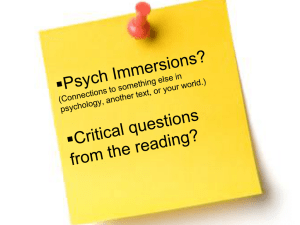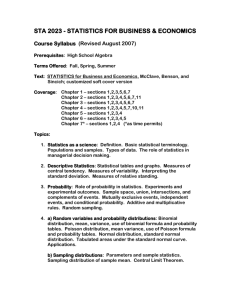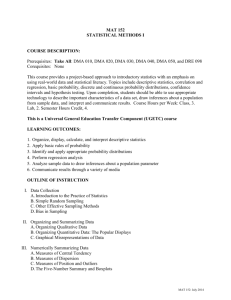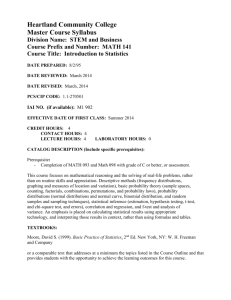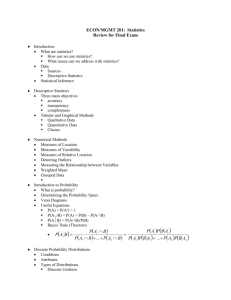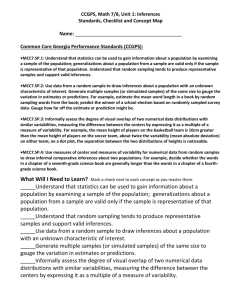Course Objectives - St. Petersburg College
advertisement
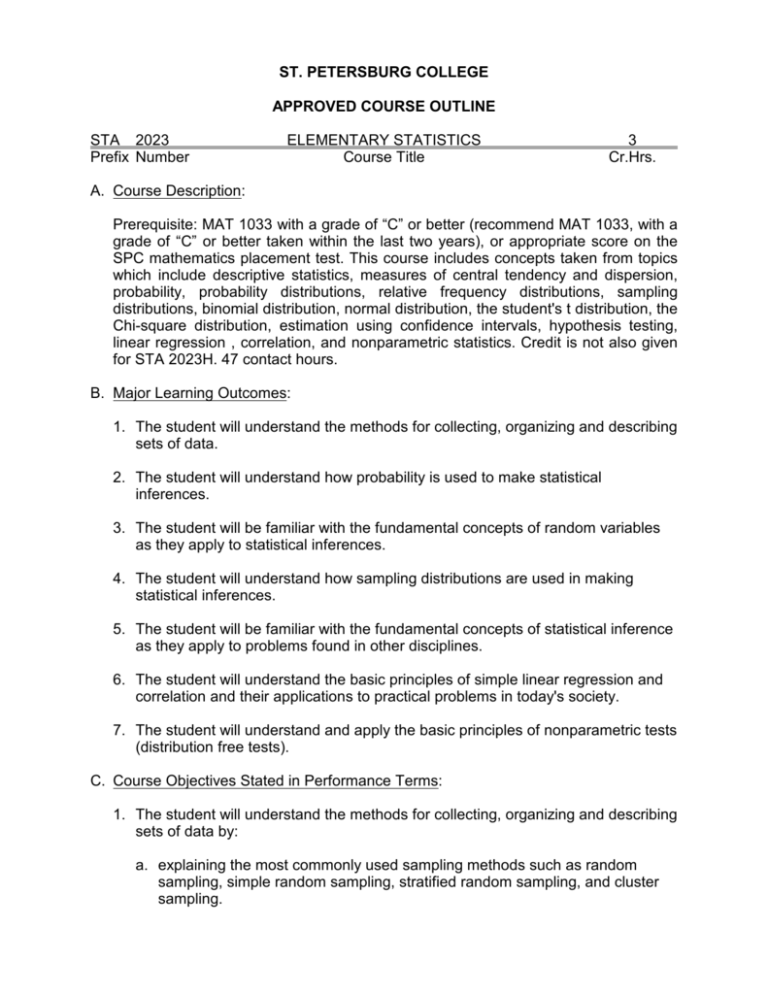
ST. PETERSBURG COLLEGE APPROVED COURSE OUTLINE STA 2023 Prefix Number ELEMENTARY STATISTICS Course Title 3 Cr.Hrs. A. Course Description: Prerequisite: MAT 1033 with a grade of “C” or better (recommend MAT 1033, with a grade of “C” or better taken within the last two years), or appropriate score on the SPC mathematics placement test. This course includes concepts taken from topics which include descriptive statistics, measures of central tendency and dispersion, probability, probability distributions, relative frequency distributions, sampling distributions, binomial distribution, normal distribution, the student's t distribution, the Chi-square distribution, estimation using confidence intervals, hypothesis testing, linear regression , correlation, and nonparametric statistics. Credit is not also given for STA 2023H. 47 contact hours. B. Major Learning Outcomes: 1. The student will understand the methods for collecting, organizing and describing sets of data. 2. The student will understand how probability is used to make statistical inferences. 3. The student will be familiar with the fundamental concepts of random variables as they apply to statistical inferences. 4. The student will understand how sampling distributions are used in making statistical inferences. 5. The student will be familiar with the fundamental concepts of statistical inference as they apply to problems found in other disciplines. 6. The student will understand the basic principles of simple linear regression and correlation and their applications to practical problems in today's society. 7. The student will understand and apply the basic principles of nonparametric tests (distribution free tests). C. Course Objectives Stated in Performance Terms: 1. The student will understand the methods for collecting, organizing and describing sets of data by: a. explaining the most commonly used sampling methods such as random sampling, simple random sampling, stratified random sampling, and cluster sampling. b. constructing and interpreting histograms and bar charts. c. calculating and interpreting the following measures of central tendency, dispersion, and relative standing, from a given data set: (1) Mean (2) Median (3) Mode (4) Variance (5) Standard deviation (6) Range (7) Z score (8) t-score (9) Percentiles 2. The student will understand how probability is used to make statistical inferences by: a. constructing a sample space in order to find the probabilities of a given simple or compound event. b. calculating probabilities of compound events using The Addition Rule and the Multiplication Rule of probabilities. c. interpreting Type I (alpha) and Type II (beta) error as probabilities when making statistical inferences. 3. The student will be familiar with the fundamental concepts of random variables as they apply to statistical inferences by: a. identifying a random variable as being discrete or continuous. b. constructing the probability distribution for a discrete random variable from a given sample space. c. calculating the probabilities of given events that are realizations of random variables: (1) having Binomial distributions. (2) those having Normal distributions. 4. The student will understand how sampling distributions are used in making statistical inferences by: a. defining sampling distribution. b. applying the Central Limit Theorem to statistical inference problems. c. recognizing that other methods, for example non-parametric methods, may apply if the distribution does not meet the stated criteria for the test. 5. The student will be familiar with the fundamental concepts of statistical inference as they apply to problems found in other disciplines by: a. stating the following for a hypothesis test: (1) the null hypothesis. (2) the alternative hypothesis. (3) the correct test statistic to be employed. (4) the appropriate conclusion for rejecting or failing to reject for a stated level of significance. (5) a conclusion or answer to the stated question. b. estimating population parameters with confidence intervals and testing a null hypothesis concerning a parameter using: (1) the student t distribution applied to population means. (2) the normal distribution applied to population proportions. (3) the chi-square distribution. 6. The student will understand the basic principles of simple linear regression and correlation and their applications to practical problems in today's society by: a. constructing and interpreting scatterplots. b. computing the following from a given set of data points: least squares equation, the Pearson product moment correlation coefficient and the coefficient of determination. c. testing a hypothesis concerning the linear relationship between two variables x and y in order to answer the question "are x and y linearly related?" d. using the linear regression equation to predict the value of a response variable y given a particular value of a predicter variable x if the linear relationship is significant. 7. The student will understand and apply the basic principles of nonparametric tests (distribution free tests) by: a. formulating the null and alternate hypothesis. b. calculating the correct test statistic to be employed. c. determining the appropriate conclusion for rejecting or failing to reject the null hypothesis for a stated level of significance. d. stating a conclusion/answer to the original claim. D. Criteria Performance Standard: The student will have to successfully complete 70% of these objectives on written tests in order to pass the course with a grade of C or better. When presented with a univariate decision-making problem regarding the mean, the student will be able to employ the appropriate hypothesis test with 70 percent accuracy (use of technology is permitted). Upon completion, the student will be able to explain his/her conclusion with 70% accuracy. Accuracy of values to at least two decimal places is expected. E. Rationale: 6/22/2010: To align the course with state guidelines. F. Textbook: th Elementary Statistics 11 edition, by Triola ISBN:9780321500243 Revised 8/84 DBT 11/20/90 C&I 3/26/96; DBT 4/17/96 Effective Session 19961 Effective Session 19911 3 YR C&I Review 8/94 DBT 5/16/95 Effective Session 19951 SCNS Change from STA 1023 1/30/96 Eff 19961; C&I 3/17/98; DBT 4/20/98 Effective Session 19981 Online/Teleweb 19981 C&I 10/23/01, BOT 11/20/01 Effective yrtr 20021 (Sess I, 2002). 2005 3-Year Review. Added exclusion 10/29/09; eff20091. C&I 6/22/2010, BOT 8/17/2010, Effective 20101(0430).
